Hayasa-Azzi › Medea › Hurrians » Origins and History
Articles and Definitions › Contents
- Hayasa-Azzi › Origins
- Medea › Who Was
- Hurrians › Origins
Ancient civilizations › Historical places, and their characters
Hayasa-Azzi › Origins
Definition and Origins
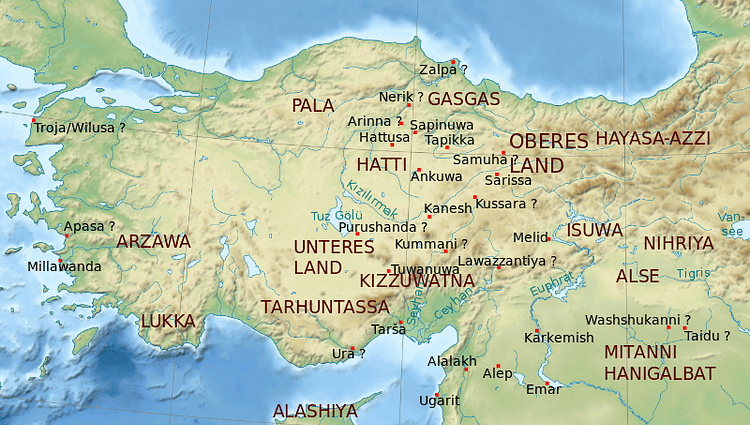
The Hayasa-Azzi were an indigenous Bronze Age tribal confederation which flourished on the plateau of ancient Armenia and Turkey between c. 1500 and c. 1200 BCE. Although the historical record is impoverished and disputed regarding the region at this time, it is known that they were enemies of the powerful Hittites further to the east, were probably infiltrated by the Thraco-Phrygians following the collapse of the Hittite Empire c. 1200 BCE, and then became part of the kingdom of Urartufrom the 9th century BCE.
ORIGINS
The Hayasa-Azzi are the eponym of the Hay people, the term Armenians use to describe themselves and their state, Hayastan. Whether there is an actual connection between the ancient Hayasa-Azzi people and the more modern Armenia state (which only first appears in records from the 6th century BCE) is still being debated amongst scholars. The first mention in the historical record of the people of the Armenian highlands is in inscriptions of the Assyrian king Shalmaneser I (r. 1274-1245 BCE) in which they are referred to as the Uruatri. The term, meaning “of the mountainous country”, likely refers to all tribes of the region and not one particular kingdom. In inscriptions of the Assyrian king Tukulti-Ninurta I (r. 1244-1208 BCE) the region is referred to as “the Land of the Nairi” and tribute is extracted from it; 43 different kings are mentioned, indicating the area had not yet achieved political unity.
THE PEOPLE, AS WITH THEIR REGIONAL SUCCESSORS IN LATER TIMES, BECAME ADEPT AT ANIMAL HUSBANDRY& FAMED HORSE-BREEDERS.
The confederation known as the Hayasa-Azzi probably included other tribes such as the Alzi (Alshe) to the south. The territory the confederation of kingdoms controlled likely extended from Ararat in the east and straddled the western Euphrates River in the south but, again, details are lacking and disputed. The heartland was, at least as presented in later tradition, in the region of Erznga (Erzinjan) on the plain of Erzerum, northwest of Lake Van.
PROSPERITY
Protected by the high altitude of the plain of Ararat with its encircling mountains and with access from Mesopotamia limited to the southwest and across the Euphrates River, the Hayasa-Azzi benefitted from a certain isolation from foreign enemies while the local geography still permitted trade links. The mountains to the south, in particular, were a formidable barrier to ancient invaders and so two distinct areas of culture developed: the more advanced Mesopotamian civilizations of the lowlands to the south and the more isolated upland plateau. However, with fertile lands and natural resources such as gold, the Hayasa-Azzi flourished. The people, as with their regional successors in later times, became adept at animal husbandry and famed horse-breeders. The pottery produced was not painted (as it was to the south) but had a highly polished black finish.

Hittite War Chariot
THE HITTITES
Four consecutive Hayasa-Azzi kings are known from the period 1390 to 1335 BCE; they are Karannish, Mariyash, Hukkanash, and Anniyash. Their dealings with the Hittite Empire illustrate the ambivalent relationship between the two states. Karannish attacked the Hittites but was rebuffed by Tudhaliya II and then by Suppiluliuma I (r. c. 1344-1322 BCE) who was busy expanding his empire in all directions. A friendlier state of affairs is indicated by Mariyash’s marriage to a Hittite princess, although he was later executed for breaching his matrimonial contract with the Hittites, to whom the Hyasa-Azzi may now have been a vassal state. Nevertheless, the arrangement was repeated when King Hukkanash married the sister of Suppiluliumaand prisoners of war were released as a consequence by both sides. Anniyash was more aggressive and attacked several Hittite outposts and then refused to release any of the prisoners he had captured. Then the Hittite king Mursili II (r. c. 1321–1295 BCE) moved eastwards and invaded Hayasa, a campaign recorded in inscriptions such as here from the Annals of Mursil:
And as I was returning from Astatan to Carchemish, the royal prince Nana-Lu came to meet me on the road and said, ‘The Hayasan enemy having besieged Ganuvara, Nuvanza marched against him and met him under the walls of Ganuvara. Ten thousand men and seven hundred chariots were drawn up in battle against him, and Nuvanza defeated them. There are many dead and many prisoners.' (in Kurkjian, 31)
The Hayasa-Azzi were severely weakened but saved from total collapse by the onset of winter and consequent withdrawal of the Hittite army, and, in the longer term, by the ultimate demise of the Hittite empire c. 1200 BCE following invasions from elsewhere, notably by the Sea Peoples.
URARTU
Over time the Hayasa-Azzi mixed with other local tribes such as the Arme-Shupria and Nairi, probably motivated by the need for defence against more aggressive and powerful neighbours such as the Hittites and then the Assyrians in the southeast. Eventually, these various kingdoms would be fused into the region’s first recognisable and recorded state, the kingdom of Urartu. With its capital at Tushpa, the Urartu civilization would flourish in Armenia, eastern Turkey, and western Iran from the 9th to 6th century BCE.
This article was made possible with generous support from the National Association for Armenian Studies and Researchand the Knights of Vartan Fund for Armenian Studies.
Medea › Origins
Definition and Origins

The tragedy Medea was written in 431 BCE by Euripides (c. 484 – 407 BCE). Euripides authored at least 90 plays of which 19 have survived intact. As with the plays by Sophocles and Aeschylus, the audience was already well aware of the myth surrounding Jason and Medea. However, Euripides’ version is slightly different, for she emerges not as a cold-blooded murderer but as a suffering mother, maligned by an unfaithful rogue of a husband. Although unpopular when it was first presented, Medea would influence both Seneca and Ovid to author their own versions of the myth.
EURIPIDES
Little is known of Euripides’ early life. He was born in the 480’s BCE on the island of Salamis near Athens to a family of hereditary priests. Although he preferred a life of solitude, alone with his books, he was married and had three sons, one of whom became a noted playwright. Unlike Sophocles, Euripides played little or no part in Athenian political affairs; the one exception was a brief diplomatic mission to Sicily. As with Sophocles and Aeschylus, his plays were performed in outdoor theaters and composed for competitions at various rituals and festivals. The intention of these performances was to not only entertain but also to educate the Greek citizen. Along with a chorus of singers to explain the action, there were two or three actors (always male) who portrayed various characters through masks and costumes. The poet made his debut at the Dionysia in 455 BCE, not winning his first victory until 441 BCE. Unfortunately, his participation in these competitions did not prove to be very successful with only four victories; a fifth came after his death.

Euripides
The Greek philosopher Aristotle (384-322 BCE) called Euripides the most tragic of the Greek poets. Classicist Edith Hamilton in her book The Greek Way concurred when she wrote that he was the saddest, a poet of the world’s grief. “He feels, as no other writer has felt, the pitifulness of human life, as of children suffering helplessly what they do not know and can never understand.” (205) With the Peloponnesian War waging, he left Athens in 408 BCE to live the remainder of his life in Macedonia. Although often misunderstood during his lifetime and never receiving the acclaim he deserved, he became one of the most admired poets long after his death, influencing not only Greek but Roman playwrights.
MAIN CHARACTERS & THE MYTH
The entire play takes place at the home of Medea; flashbacks inform the audience of her time in her native Colchis and her arrival in Greece as a foreigner. The characters are few: Medea, Jason, King Creon, King Aegeus, the children, a nurse, a tutor, a messenger, and the chorus. According to the legend, the princess Medea of Colchis fell madly in love with Jason of Argonauts and helped him retrieve the Golden Fleece by using her powers of sorcery. She immigrated to Corinth with Jason where she would bear him two sons. Unfortunately, Jason decided to divorce Medea and marry someone more prominent, the daughter of Creon, the king of Corinth. Jason claimed he had the moral right to leave Medea for he had fulfilled his primary duty by bearing legitimate children. Medea did not take the news very well.
IN EURIPIDES’ VERSION, MEDEA EMERGES NOT AS A COLD-BLOODED MURDERER BUT AS A SUFFERING MOTHER, MALIGNED BY AN UNFAITHFUL ROGUE OF A HUSBAND.
Creon approached Medea and informed her that she was to be exiled; he believed she might harm his daughter. Visibly upset, she begs for one more day, and she is granted her request. The king was right. Seeking revenge, she decided to kill not only Jason’s new bride but also her children. Meanwhile, she was offered asylum in Athens by its king Aegeus. By the following day, she has not only poisoned Jason’s bride but Creon as well. With the murder of her children, she confronts Jason. Hovering above him in the sky, she rides off in a chariot provided by her grandfather Helios, the sun god, leaving Jason standing alone without either a bride or children. This was Euripides’ version. In other adaptations of the myth, she kills the children accidentally while trying to make them immortal or the citizens of Corinth kill them at the temple of Hera because of Medea’s murder of the princess.

Medea Sarcophagus
THE PLOT
The play begins sometime after Medea has learned about Jason’s plan to marry King Creon’s daughter. She is inside her home, crying and bemoaning about her plight. The children’s nurse is outside, concerned about her mistress’s mental state. She speaks to the audience:
… now hatred rules, and loyal love is sick since Jason has betrayed my mistress and their sons, by mounting the royal bridal bed beside the daughter of Creon, the monarch of this land, and so my poor Medea is disdained. (Grene, 74)
The nurse suspects that something horrible may happen for Medea now hates the children and takes no pleasure in the sight of them. She fears that Medea could even do them harm. When the children’s tutor enters, they exchange a little gossip about what each of them suspects. He is concerned about Medea and wonders if she had stopped grieving. The tutor is told to keep the children away from their mother until she has stopped grieving.
The scene changes to Medea inside the house:
The suffering I have endured, endured, calling for bitter lament aloud! Accursed children of a hated mother, I wish you were done for along with your father. To hell with family, all of the house. (78)
She even begs for death. She speaks to the gods Artemis and Themis asking if they can see the pain she is suffering. She pleads that they rip the palace to pieces for what has been done to her. The nurse hears Medea’s plea and adds - speaking to the gods - she fears for the children’s safety but begs for the gods to help. Medea appears from inside the house and speaks to the audience of Jason. Addressing the women of Corinth about men in general, she says they believe women enjoy life, secure from danger, while they fight in wars. However, she would rather fight in battle than endure childbirth.
Manhandled from a foreign land like so much pirate loot … if I can find some means or some device to make my husband pay the penalty to quit me… (81)
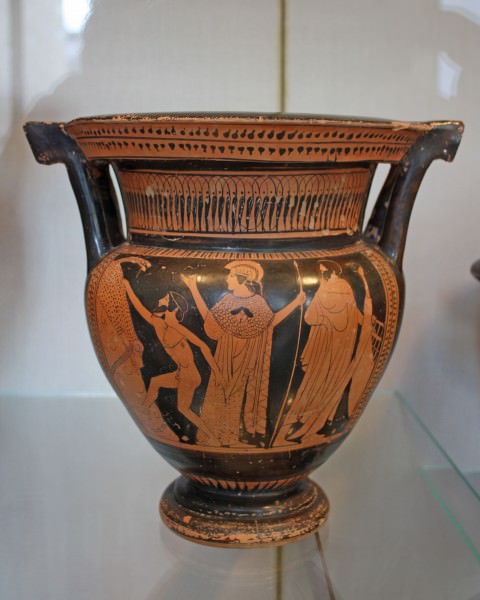
Attic Column-Krater
King Creon approaches Medea and informs her that she must leave Corinth. She asks for the reason why he is expelling her. Creon replies: “I am afraid of you - no point in mincing words - I am afraid you’ll work incurable mischief upon my daughter” (84). Medea assures him that it is Jason she hates, not the bride. Despite her pleas, Creon still holds to her being exiled.
He will even have her removed by force if necessary. Medea relents and asks only for one more day to make arrangements for her sons, and Creon agrees. After he leaves, she declares aloud:
… he’s let me stay for this one day - the day on which I shall make dead meat of my enemies all three: the father and his daughter and my husband. (88)
Jason enters and approaches Medea, assuring her that she will not be left in poverty. First, she calls him a cheating rat and then reminds him how she had left her home after helping him acquire the Golden Fleece. Jason ignores her and says she has no one to blame for her exiles except herself. He has grown to hate her, but he still intends to treat her well.
I am prepared to hand out generously and to send tokens to my friends elsewhere to have them treat you well. If you refuse this, woman, you are a fool. Give up your anger fit, and you will be far better off. (97)
He leaves her standing alone. Aegeus, King of Athens, arrives to speak to Medea. He has come from the oracle of Apollowhere he had asked how he might acquire children as his heirs. He understood that there was a prophet in Corinth that could help him. He asks why she has been crying. Medea relays her problems with Jason. The king sympathizes, and Medea adds that she can end his barrenness. “I shall make you potent to seed progeny. Such are the potions that I know.” (103) Aegeus promises her that if she can escape Corinth, he will give her asylum in Athens. After the king leaves, Medea prays to Zeus and says that she now has hope. Speaking to the audience, she divulges her plan. She will inform Jason that she wishes him well and has a present to give the princess, a finespun dress and plaited wreath of beaten gold. However, unbeknownst to anyone else, the dress will be poisoned. Concerning the fate of her children, she adds:
I grieve for the deed that I must do then that I must kill my sons - there is no one can spirit them away. (106)
Jason reappears as she has requested and Medea asks for his forgiveness. She calls for her children and assures them that she is no longer angry. Jason is pleased because her actions are of a woman who has finally become sensible. Medea assures him that she was only thinking of the children. They are to stay with Jason. She requests only that they will not be exiled. Jason leaves, and Medea and the tutor speak. The princess has been given the gifts. Turning to his children, Medea tells them that she is to be exiled. Speaking to herself, she realizes there is only one thing left to do:
…. there is no way I shall leave my boys among my enemies so they can treat them with atrocity. (117)
If they must die then it has to be by her hands. A servant arrives with news; the princess and her father are dead. She rejoices; it is excellent news.
My deed has been decided, friends --- as quickly as I can I’ll end the children’s lives and move on from this land. (124)
Medea exits and enters the house, saying “I’m a woman made of sorrow.” The children are killed off stage. Jason appears with the sword in hand that had killed his boys. Medea hovers above him in a chariot holding the bodies of her two sons. Jason speaks to her:
You are a thing of hate, woman most loathsome to the gods and me, and all humanity. (128)

Helios
No Greek would ever have done what she did. Medea tells him that Zeus knows what he has done. Jason grieves not only that he shall never share his marriage bed but also not share words with his two children again. Jason calls Medea a vicious mother, but she quickly responds that it was not her hand but his hand that killed them. She tells him that the gods know who is responsible. Jason asks for the bodies of his sons so he can bury them. No! Medea responds that they will be buried at the shrine of Hera. She adds that everything she did was meant to torture him. Medea flies away, leaving Jason standing alone - no wife, no children. Calling to Zeus, blaming the god for allowing this to happen:
...what I have suffered at the hands of this polluted, this children-devouring she lion. (133)
INTERPRETATION
In Medea, Euripides portrayed a woman already known to the audience through the myth of the Argonauts and the hunt for the Golden Fleece. Some critics consider him to be a misogynist for his portrayal of women as being murderous and terrifying; however, he actually had deep respect and sympathy for women. Michael Grant in his book The Classical Greeks stated that the poet admired women for their sacrifice and pitied them for their suffering.
According to John Davie in the introduction to his translation of Euripides’ play, the poet was intrigued by the mind of Medea. He believed she was not a heartless woman, but one who is suffering. As a foreigner in a strange land, she is presented as a pathetic victim, a tormented mother. She murdered not out of hatred but out of passion. Michael Grant claimed the play has a novel theme, the “power of passion.” Medea was transformed into a fiend by an intolerable wrong. Despite the darkness of her actions, she knew exactly what she was doing.
She is not depicted as a murderous, heartless mother. She is a victim, betrayed by a husband who wanted to marry another, someone more prominent. During his lifetime, Euripides saw his adopted city suffer through the hardships of the Peloponnesian War. He saw that the war not only affected the men who were fighting the battles but the women who remained at home. Euripides saw the evil beneath the war. As Hamilton wrote: “No poet’s ear has ever been so sensitively attuned as his to the still, sad music of humanity…” (205). In some ways, Medea represented this suffering. Although Jason was not at war, she still felt betrayed and abandoned.
Hurrians › Origins
Definition and Origins
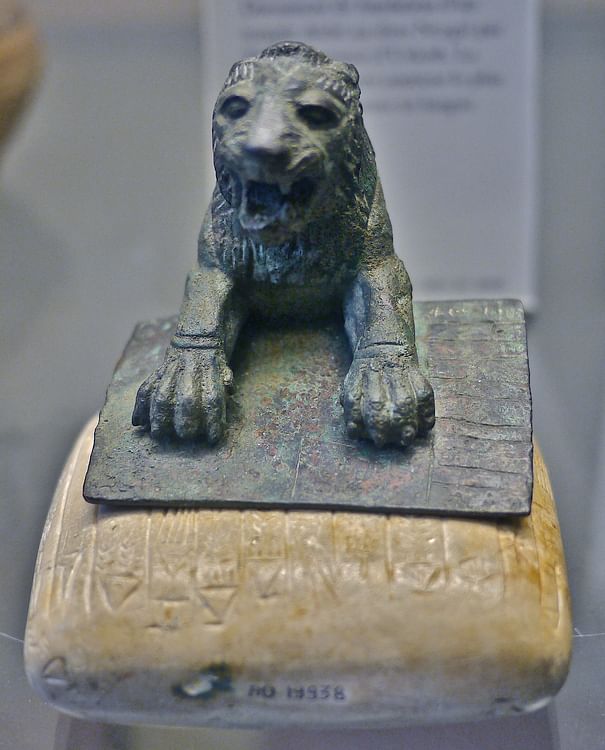
The Hurrians (aka Hurri or Khurri) were a Bronze Age people who flourished across the Near East from the 4th millennium BCE to the 1st millennium BCE. Hurrian is also the name of the language these people spoke and, indeed, is the one constant and identifying feature of the culture over time and geography. Hurrians formed the principal cultural element of the Bronze Age Mitannikingdom and blended with the culture of the neighbouring, and then conquering, Hittites. By the late Bronze Age, the Hurrians had been assimilated into surrounding cultures in the Near East but many of their gods and myths would live on in later cultures, notably the Urartu civilization, and even inspire elements of myth found in Archaic Greece.
DIFFICULTIES IN DEFINITION
The difficulties in precisely identifying who the Hurrians were and when they existed in various locations are here summarised in the relevant entry of the Encyclopedia of Ancient History:
Probably Hurri was originally the designation borne by the population group, which was then applied to the land they inhabited and the language they spoke. However, that population and that land were not precisely delimited in genealogical terms; only the Hurrian language, which anyone could acquire, was a distinct and constant feature. (3345)
In addition, the language itself also presents difficulties of interpretation. Hurrian has only one other related ancient language, Urartian, and their connection to any living languages is uncertain. The Hurrian language was written using the cuneiformscript, although some surviving texts from Ugarit use the Ugaritic alphabet.
The Encyclopedia of Ancient History gives the following concise description of the features of the Hurrian language:
Typologically, Hurrian is an agglutinating language with ergative grammar, unlike Indo-European and Semitic languages but like the Sumerian language. Notwithstanding their lack of genealogical relationship, Hurrian and other ancient Near Eastern languages shared onomastic patterns as well as numerous lexemes. (3345)
For the moment, the Hurrians and their language remain one of the most enigmatic cultures of the ancient world, as here summarised succinctly by the historian Professor Holger Gzellar, "the origin of the Hurrians…is unknown, just like much of their culture and society" (in Steiner, 26). Greater information and clarity are to be hoped for from ongoing excavations at Hurrian cities such as Urkesh in northeast Syria, and it is, at least, possible to piece together a limited history from an examination of the Hurrians’ neighbouring and contemporary cultures.
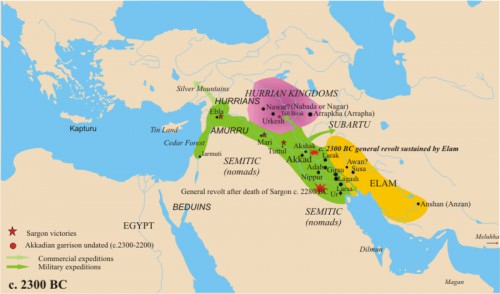
Map of the Akkadian Empire
Finally, the Hurrians have been caught up in the controversial “Aryan question” - that is the proposal that Aryans from central Asia invaded and settled in the Near East - but there is little evidence besides a few linguistic terms of Indo-Aryan origin ( which were, in any case, Hurrianised) to positively identify the presence of Aryans in Mitanni (see below) or the Near East in general. Nor is the argument that horses and chariots were introduced by Aryan migrants convincing as both were already present in the region before such a migration is proposed. A very few foreign gods in the Hurrian pantheon have names of Indic origin, but they are of such a small percentage that they form a weak argument for a cultural invasion, especially as, when they do appear, it is in treaties arranged during the later stages of the Mitanni Empire when it was in decline and not, as might be expected, during its foundation.
HISTORICAL OVERVIEW
4th-3rd millennium BCE
Hurrian speakers inhabited a core area, that is the upper Habur and Tigris rivers up to the Taurus and Zagros mountains, especially around Lake Van. Textual evidence of the Hurrians dates to the mid-3rd millennium BCE but, based on archaeological evidence, it is likely the culture at least stretched back to the mid-4th millennium BCE. Generally known in ancient sources as the Hurri, the culture and language may also be referred to as the Subartu or Subareans, while in biblical texts they are the Horites (strictly speaking the descendants of the Hurrians in Canaan).
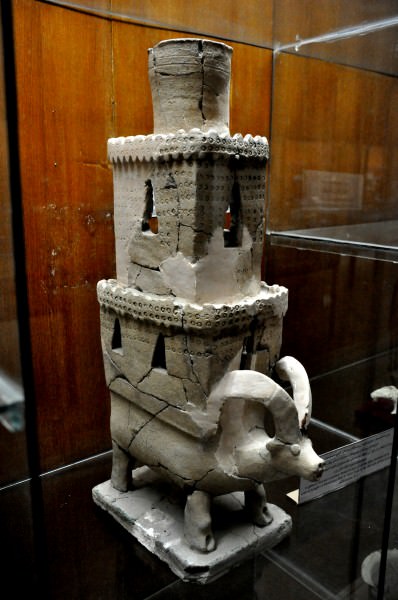
Mesopotamian Incense Container
One of the earliest and most important Hurrian sites was Urkesh, and it is from here that the earliest known inscriptions of the language were discovered. Other Mesopotamian city-states with evidence of the worship of Hurrian gods and personal names include Kharbe and Nagar. Starting from the 4th millennium BCE, then, the Hurrians thrived and expanded across Upper Mesopotamia. And here the culture presents yet another difficulty in definition and identification, as explained by the historian Professor W. J. Hamblin:
It was likely that the Hurrian conquest of that region was a complex phenomenon including peaceful migration, infiltration by mercenary bands in the pay of local city-states, followed by the rise of to power of mercenary warlords…culminating in the eventual full-scale migration of Hurrian herding tribes out of the mountains into the more fertile river valleys. (304)
Further, the Hurrians often seem to have adopted the culture of the city-states they conquered, making them less visible than ever in the historical record. For example, "we have no evidence of a distinctive Hurrian military system" (ibid). It seems that if ever there were a people who were both everywhere and nowhere, it was the Hurrians.
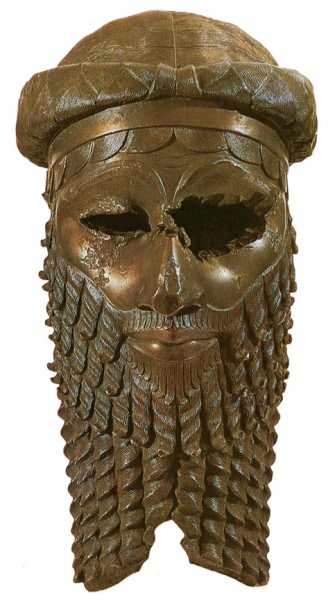
Akkadian Ruler
Their expansion was sometimes halted by other regional powers, especially Assyria. During the reigns of Sargon the Great(r. 2334-2279 BCE) and Naram-Sin (r. 2261-2224 BCE), in particular, the rulers of Akkad waged a successful war of expansion in northern Mesopotamia which likely saw them defeat several Hurrian city-states, among them Nagar, which was made an Akkadian regional capital.
WHEN THE KINGDOM OF AKKAD FELL C. 2190 BCE, THE HURRIANS EXPLOITED THE CONSEQUENT POWER VACUUM IN MESOPOTAMIA.
2190-1900 BCE
When the kingdom of Akkad fell c. 2190 BCE, the Hurrians (and others) exploited the consequent power vacuum in Mesopotamia. There was no Hurrian Empire as such but some of the independent city-states ruled by Hurrian kings may well have formed together in a loose confederation. Still others were in conflict with each other. Urkesh and Nagar continued to be important Hurrian centres in this period, which is known only through scattered fragments of inscriptions. In the last century of the 3rd millennium BCE, Hurrian cities were attacked and conquered by Sumer, particularly during the reign of kings Utuhegal of Uruk (r. 2117-2111 BCE) and Shulgi of Ur (r. 2029-1982 BCE). Despite this new threat, the Hurrian heartlands and their capital Urkesh remained untouched. Indeed, under the king Tish-atal (r. c. 2010), Nineveh was under Hurrian control, perhaps even Harhar in western Iran, too.
1900-1200 BCE
By the second quarter of the 2nd millennium BCE, the Hurrians were migrating into northern Syria and eastern Anatolia as they moved westwards and southwards. Once again, military conquest was mixed with the peaceful migration of Hurrian merchants, farmers, artisans, and nomads. The Hanigalbat, an area of upper Mesopotamia, became the heartland of the Mitanni kingdom (c. 1500-1240 BCE) which was predominantly Hurrian in culture.
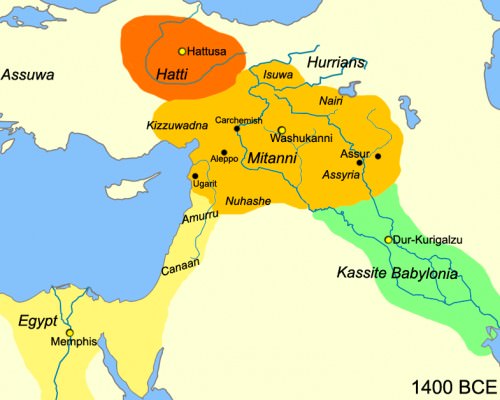
Map of Mesopotamia, c. 1400 BCE
From the 16th-15th century BCE, there was increasing antagonism between the HittiteEmpire (c. 1700-1200 BCE) and Mitanni. This was a continuation of the hostilities between Hittites and Hurrians which had been going on in the 17th century BCE - Syria being a particular bone of contention. Although a consequence of Hittite expansion was that, as more Hurrians came under Hittite rule, there was a further spreading of Hurrian cultural elements westwards, especially deities, which were borrowed and loaned between the two cultures and others in the region. For example, the Hurrian storm god Tessub became identified with the Anatolian god of the same function, Tarhunza. Once more, the Hurrian culture was being assimilated by both friend and foe across the region.
Following the conquest and division of Mitanni by Assyria and Hatti in the mid-13th century BCE, the Hurrian language and culture continued under the political control of the Hittites and Assyrians. By the 1st millennium BCE, the Hurrians had been absorbed into other cultures of the region but, as previously, elements of their culture became intermixed with that of their successors. For example, the god Tessub became Teisheba in the religionof the Urartu civilization which spread across ancient eastern Turkey, Armenia, and western Iran from the 9th to 6th century BCE. Similarly, elements of Hurrian mythologyand literature would be translated and preserved by Hittite scribes which would then eventually cross the Aegeanand inspire elements of the mythology of Archaic Greece.
This article was made possible with generous support from the National Association for Armenian Studies and Researchand the Knights of Vartan Fund for Armenian Studies.
LICENSE
Article based on information obtained from these sources:with permission from the Website Ancient History Encyclopedia
Content is available under License Creative Commons: Attribution-NonCommercial-ShareAlike 3.0 Unported. CC-BY-NC-SA License